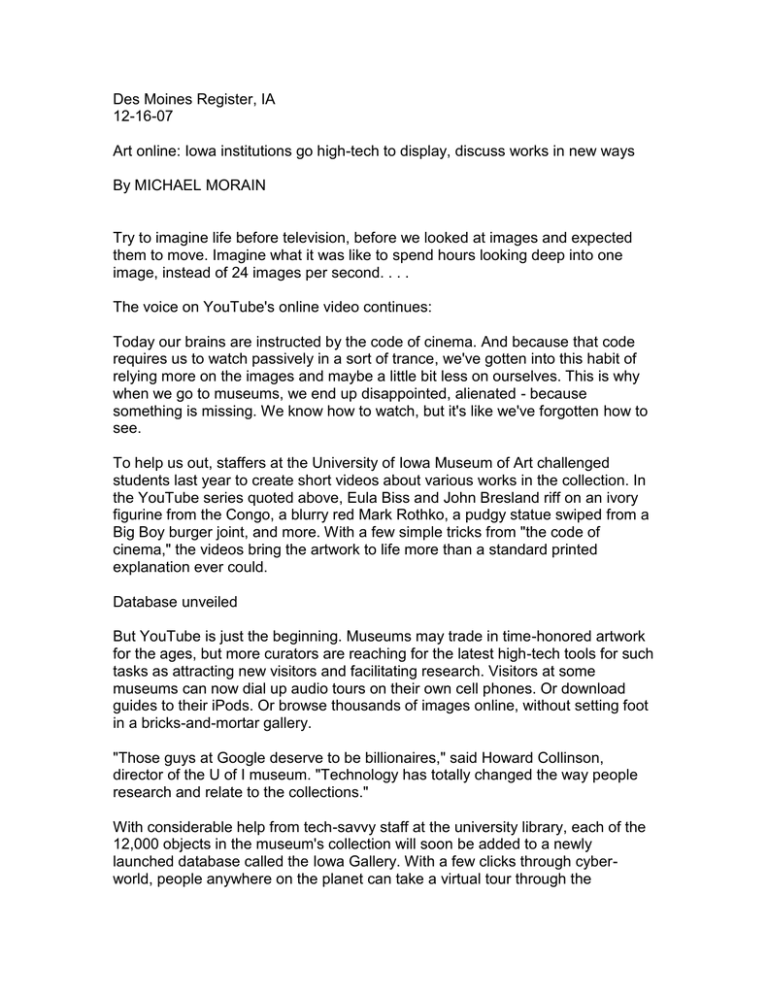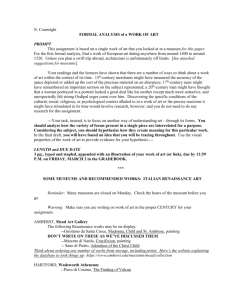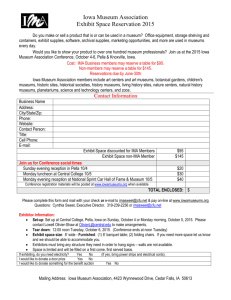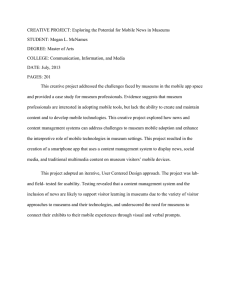Des Moines Register, IA 12-16-07
advertisement

Des Moines Register, IA 12-16-07 Art online: Iowa institutions go high-tech to display, discuss works in new ways By MICHAEL MORAIN Try to imagine life before television, before we looked at images and expected them to move. Imagine what it was like to spend hours looking deep into one image, instead of 24 images per second. . . . The voice on YouTube's online video continues: Today our brains are instructed by the code of cinema. And because that code requires us to watch passively in a sort of trance, we've gotten into this habit of relying more on the images and maybe a little bit less on ourselves. This is why when we go to museums, we end up disappointed, alienated - because something is missing. We know how to watch, but it's like we've forgotten how to see. To help us out, staffers at the University of Iowa Museum of Art challenged students last year to create short videos about various works in the collection. In the YouTube series quoted above, Eula Biss and John Bresland riff on an ivory figurine from the Congo, a blurry red Mark Rothko, a pudgy statue swiped from a Big Boy burger joint, and more. With a few simple tricks from "the code of cinema," the videos bring the artwork to life more than a standard printed explanation ever could. Database unveiled But YouTube is just the beginning. Museums may trade in time-honored artwork for the ages, but more curators are reaching for the latest high-tech tools for such tasks as attracting new visitors and facilitating research. Visitors at some museums can now dial up audio tours on their own cell phones. Or download guides to their iPods. Or browse thousands of images online, without setting foot in a bricks-and-mortar gallery. "Those guys at Google deserve to be billionaires," said Howard Collinson, director of the U of I museum. "Technology has totally changed the way people research and relate to the collections." With considerable help from tech-savvy staff at the university library, each of the 12,000 objects in the museum's collection will soon be added to a newly launched database called the Iowa Gallery. With a few clicks through cyberworld, people anywhere on the planet can take a virtual tour through the museum's galleries. They can even tailor their exploration according to their tastes, grouping their search by artist (say, Henry Moore or Joan Miro), medium (batik, photography, porcelain) or time period (all the way back to the 10century). Iowa Gallery expands In addition to the museum's collection, the Iowa Gallery includes 40 years of graduate-student work from the university's School of Art and Art History and thousands of images from the Daily Palette, a Web site that has featured a different Iowa artist each day since it was created four years ago. In all, the Iowa Gallery provides user-friendly access to more than 15,000 images - and it's growing. "It's kind of an evolutionary thing," said museum collections manager Jeff Martin, who remembers the first clunky computer databases in the early 1980s. Each new technological advance brings new challenges. "A lot of the images were scanned from old slides or early-generation digital cameras," said Martin, who's working with more than 30 staffers from the museum and library to update the digital records. "It takes a lot of time, as you can imagine, but we're very close to having a photo of everything in the collection." ISU aims for spring In Ames, staffers at the Iowa State University Museums are working on a similar project and hope to unveil a digital database of their 30,000-object collection during the spring semester. "It's all about getting things online, not only for the general public but other museum professionals," said ISU Museums program coordinator Allison Sheridan, who traveled to Chicago earlier this year for a tech-focused conference with the American Association of Museums. "You have to be a trendsetter or at least on the fringe of the trend in the museum world because you're competing for the same audience." In the meantime, Sheridan is putting the finishing touches on an innovative virtual tour of sculptures scattered across campus. The resource, called the Digital Art on Campus Project, is the brainchild of Grant Thompson, who graduated recently with degrees in horticulture and landscape architecture. Thanks to his project, anybody with a laptop can plop down next to any of 18 sculptures on campus, access the campuswide wireless system and see a short video about the piece. The tours are also available in an iPod-friendly audio format, perfect for a personalized walking tour. "Conventional signage is often inadequate or inappropriate," said Thompson, who cooked up the idea after listening to hand-held "Acoustiguides" in museums in France and Italy. "That's a pretty common way of doing things, but my dad (former State Historical Society director Jerome Thompson) is a museum person, so I thought about what role the Internet could play." Unwrapping puzzle Elsewhere in Iowa, the Des Moines Art Center plans to create some kind of interactive guide for the Pappajohn Sculpture Park scheduled for installation in downtown's Western Gateway Park sometime next year. Museum leaders hope a multimedia resource - even a short audio recording - will help people understand some of the more puzzling aspects of Louise Bourgeois' giant bronze spider, Willem de Kooning's curvy "Reclining Figure" and other works in the park. Although high-tech bells and whistles can enhance interaction with art, some experts worry that virtual tours and online catalogs prevent people from taking time to study the real deal. After all, a 3-inch photo can never capture the subtle variations of a full-scale Monet or the buzzing color of a Matisse. The U of I museum's Collinson compared the computerized images on the new Iowa Gallery to a recent show on TV's Food Network. "Bobby Flay held something up to the screen and said, 'Mmmm, smell that!' Well, it's not quite the same," Collinson said. "It's certainly useful to have an image online, but I don't think it replaces the real thing." Even so, he hopes innovations such as the YouTube videos help people see the museum's artwork in new ways. Consider, for example, Biss and Bresland's informal YouTube take on Jackson Pollock's 1943 "Mural": There are a thousand books that attempt to explain his work. And let's face it, Pollock's work could use some explaining. It's abstract. And what people like to say about abstract painting is that it's completed by the viewer. That is, you, the viewer, supply its meaning. And that hardly seems fair, does it? Pollock does all the cooking, and you clean up the mess. It's not exactly the Food Network, but there's a good chance chef Flay - and anyone else who's been in a kitchen - can relate. Reporter Michael Morain can be reached at (515) 286-2559 or mmorain@dmreg.com







